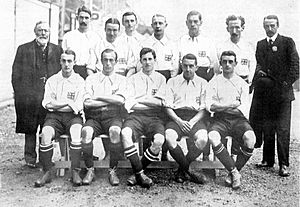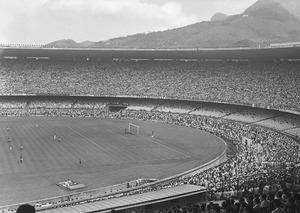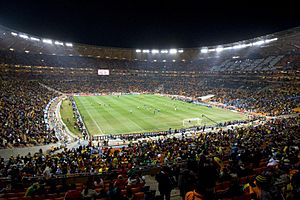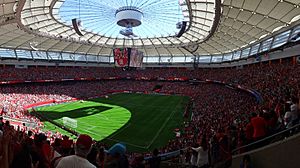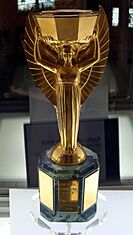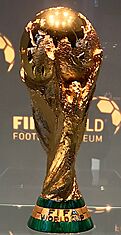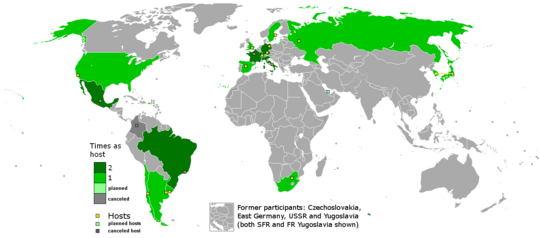FIFA World Cup facts for kids
| Organising body | FIFA |
|---|---|
| Founded | 1930 |
| Region | International |
| Number of teams | 32 (48 from 2026 onwards) |
| Related competitions | FIFA Women's World Cup FIFA U-20 World Cup FIFA U-17 World Cup |
| Current champions | |
| Most successful team(s) | |
The FIFA World Cup, often called the World Cup, is a huge international football competition. It features the best men's national teams from around the world. These teams are all part of FIFA, which is the global group that runs football.
The tournament happens every four years. It started in 1930, but it was paused in 1942 and 1946 because of World War II. The current champions are Argentina. They won their third title at the 2022 World Cup by beating France.
To get into the World Cup, teams first go through a qualification phase. This takes about three years. Then, 32 teams compete for the title in the host country or countries. This final tournament lasts about a month. The host nation automatically gets a spot in the tournament. Starting with the 2026 World Cup, the number of teams will grow to 48.
Since 1930, there have been 22 World Cup tournaments. A total of 80 national teams have played in them. Only eight national teams have won the famous trophy. Brazil has won five times and is the only team to have played in every tournament. Other winners include Germany and Italy (four titles each), Argentina (three titles), France and Uruguay (two titles each), and England and Spain (one title each).
The World Cup is seen as the most important football competition globally. It's also the most watched sports event in the world. About 3.57 billion people watched the 2018 World Cup. For the 2022 World Cup, about 5 billion people engaged with the event, and around 1.5 billion watched the final match.
Eighteen countries have hosted the World Cup. Qatar hosted the most recent one in 2022. The 2026 tournament will be held in Canada, Mexico, and the United States. This will make Mexico the first country to host games in three World Cups.
Contents
History of the World Cup
Early International Football
The very first international football match was played in Glasgow in 1872 between Scotland and England. The first tournament for nations, the British Home Championship, started in 1884. It included England, Scotland, Wales, and Ireland.
As football became popular worldwide, it was played at the 1900 and 1904 Summer Olympics. However, no medals were given then. Later, the International Olympic Committee decided these were official events.
In 1908, football became an official Olympic sport at the London Summer Olympics. This event was only for amateur players. Great Britain won the gold medal, and they won again in 1912.
Because the Olympics only allowed amateur teams, Sir Thomas Lipton created the Sir Thomas Lipton Trophy in 1909. This was a championship for club teams from different countries. Some people called it "The First World Cup."
In 1914, FIFA agreed to manage the Olympic football tournament. This led to the first intercontinental football competition for nations at the 1920 Summer Olympics. Belgium won that tournament. Uruguay then won the next two Olympic football tournaments in 1924 and 1928. These were the first "open" world championships, meaning professional players could compete. This is why Uruguay wears four stars on their jersey, representing these wins.
The First World Cups
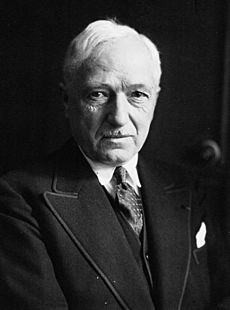
After the success of the Olympic tournaments, FIFA, led by President Jules Rimet, wanted to create its own international tournament. On May 28, 1928, FIFA decided to hold a world championship. Uruguay was chosen to host the first World Cup in 1930. This was also to celebrate 100 years of Uruguay's independence.
It was hard to get European teams to travel to Uruguay because it was a long, expensive trip during the Great Depression. Only four European countries agreed to send a team. In total, 13 nations played: seven from South America, four from Europe, and two from North America.
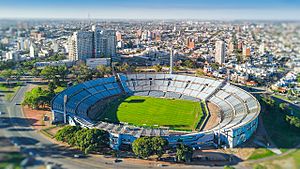
The first two World Cup matches happened on July 13, 1930. France and the United States won their games. Lucien Laurent of France scored the first World Cup goal ever. In the final, Uruguay beat Argentina 4–2 in front of 93,000 fans in Montevideo. Uruguay became the first World Cup champion. After the World Cup began, football was removed from the 1932 Summer Olympics for a short time. It returned in 1936, but the World Cup was now the bigger event.
Early World Cups faced challenges like difficult travel and war. Few South American teams traveled to Europe for the 1934 World Cup. Most North and South American teams boycotted the 1938 tournament. The 1942 and 1946 World Cups were canceled because of World War II.
World Cups After World War II
The 1950 World Cup in Brazil was the first to include British football teams again. These teams had left FIFA in 1920 but rejoined in 1946. The 1930 champions, Uruguay, also returned after boycotting the previous two World Cups. Uruguay won the tournament again, beating host nation Brazil in a famous match called "Maracanazo."
From 1934 to 1978, 16 teams played in each tournament. Most teams were from Europe and South America. Teams from other parts of the world usually struggled against them. Before 1982, only a few teams from outside Europe and South America made it past the first round.
More Teams Join the World Cup
The tournament grew to 24 teams in 1982. Then, it expanded to 32 teams in 1998. This allowed more teams from Africa, Asia, and North America to join. Since then, teams from these regions have done better. Some have even reached the quarter-finals or semi-finals. For example, South Korea finished fourth in 2002, and Morocco finished fourth in 2022. However, European and South American teams still mostly win the top spots.
A record 204 countries tried to qualify for the 2010 FIFA World Cup.
World Cup Expansion to 48 Teams
In October 2013, FIFA President Sepp Blatter suggested giving more World Cup spots to teams from Africa and Asia. He believed the World Cup should truly be global.
Later, in October 2016, FIFA president Gianni Infantino supported a 48-team World Cup for 2026. On January 10, 2017, FIFA confirmed that the 2026 FIFA World Cup would have 48 teams. This new format will have 12 groups of four teams. The top two teams from each group, plus the best eight third-placed teams, will move on to a new round of 32.
Other FIFA Tournaments
There's also a World Cup for women's football, the FIFA Women's World Cup. It started in 1991 in China. The women's tournament is growing in popularity.
Men's football has been part of almost every Summer Olympic Games. However, it's not a top-level tournament for men. Since 1992, it's been mostly for players under 23, with a few older players allowed. Women's football joined the Olympics in 1996.
FIFA also organizes other international tournaments. These include youth football (like the FIFA U-20 World Cup and FIFA U-17 World Cup), club football (the FIFA Club World Cup), and other types of football like futsal (FIFA Futsal World Cup) and beach soccer (FIFA Beach Soccer World Cup).
The World Cup Trophy
From 1930 to 1970, the winning team received the Jules Rimet Trophy. It was first called the World Cup, but was renamed in 1946 after FIFA president Jules Rimet. In 1970, Brazil won the tournament for the third time, which meant they got to keep the trophy forever. Sadly, the trophy was stolen in 1983 and has never been found. It's thought that the thieves melted it down.
After 1970, a new trophy was designed, called the FIFA World Cup Trophy. Experts from seven countries chose the design by Italian artist Silvio Gazzaniga. The new trophy is 36 centimeters (14 inches) tall. It's made of 18 carat (75%) solid gold and weighs 6.175 kilograms (13.61 pounds).
The bottom of the trophy has two layers of green malachite. The names of the World Cup winners since 1974 are engraved on the bottom. The new trophy is not kept by the winning nation permanently. Winners get to hold it during their celebration, but then they receive a gold-plated copy.
Players, coaches, and managers from the top three teams get medals. Winners get gold, runners-up get silver, and third-place teams get bronze. Since 2006, World Cup winners also get to wear the FIFA Champions Badge on their jerseys until the next World Cup.
How the Tournament Works
Qualification Process
Since the second World Cup in 1934, teams have had to qualify to play in the final tournament. Qualification games are held in six FIFA regions: Africa, Asia, North and Central America and Caribbean, South America, Oceania, and Europe. Each region has its own qualifying tournaments. FIFA decides how many spots each region gets in the World Cup.
The qualification process can start almost three years before the main tournament. It usually lasts for two years. Host nations automatically qualify for the final tournament. Until 2002, the defending champions also automatically qualified. But starting in 2006, even the champions have to play in qualification matches. Brazil, who won in 2002, was the first defending champion to go through qualification.
The Final Tournament
Since 1998, the final tournament has had 32 national teams. They compete over about a month in the host countries. The tournament has two main parts: the group stage and the knockout stage.
In the group stage, teams are divided into eight groups of four teams each. Eight teams are "seeded," meaning they are placed in separate groups to ensure strong teams don't play each other too early. These include the hosts and other top-ranked teams. The other teams are drawn into groups, often based on their region.
Each team in a group plays every other team in that group once. This means six matches are played in total within each group. The last games of each group are played at the same time to keep things fair. The top two teams from each group move on to the knockout stage. Teams get points for their games: three points for a win, one for a draw, and none for a loss. If teams have the same points, tie-breaking rules like goal difference are used.
The knockout stage is like a bracket tournament. Teams play one-off matches. If a game is tied after regular time, they play extra time. If it's still tied, they have a penalty shootout to decide the winner. This stage starts with the Round of 16, then moves to the quarter-finals, semi-finals, a match for third place, and finally, the World Cup final.
As of March 2023, FIFA approved a new format for the 2026 tournament. It will have 12 groups of four teams. The top two teams from each group, plus the best eight third-placed teams, will advance to a new Round of 32.
Host Countries
How Hosts Are Chosen
In the early days, World Cup hosts were chosen at FIFA meetings. This was sometimes controversial because travel between South America and Europe was very long. For example, when Uruguay hosted the first World Cup in 1930, only four European nations came. The next two World Cups were in Europe, which upset South American countries.
Since the 1958 World Cup, FIFA tried to alternate hosts between the Americas and Europe to avoid problems. The 2002 FIFA World Cup, hosted by South Korea and Japan, was the first in Asia and the first with more than one host. South Africa became the first African nation to host in 2010. The 2014 FIFA World Cup in Brazil was the first time two World Cups in a row were held outside Europe.
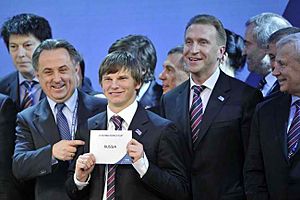
Today, the host country is chosen by a vote from FIFA's Council. Countries that want to host get a "Hosting Agreement" from FIFA. This explains what they need to do to bid. FIFA inspectors visit the countries to make sure they can meet the requirements. The decision is usually made six or seven years before the tournament. Sometimes, hosts for multiple future tournaments are announced at once, like for the 2018 and 2022 World Cups. Russia and Qatar were chosen, making Qatar the first Middle Eastern country to host.
For the 2010 and 2014 World Cups, only countries from certain regions could bid. This was to make sure different continents got a chance to host. However, this rule changed after 2014. Now, any country can apply to host, as long as their region didn't host the two previous tournaments.
The 2026 FIFA World Cup will be held in the United States, Canada, and Mexico. This is the first time three nations will share hosting duties. It will be the biggest World Cup ever, with 48 teams playing 104 matches. The US will host 60 matches, including all games from the quarter-finals onwards. Canada and Mexico will each host 10 games.
Host Nation Success
Six of the eight World Cup champions have won a title while playing in their home country. The only exceptions are Brazil and Spain. England won its only title as a host nation in 1966. Uruguay (1930), Italy (1934), Argentina (1978), and France (1998) all won their first titles at home.
Other host nations have also had their best results when hosting. For example, South Korea finished fourth in 2002. So far, South Africa (2010) and Qatar (2022) are the only host nations that did not make it past the first round.
Broadcasting and Promotion
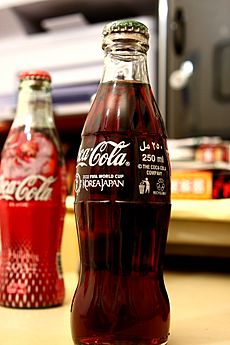
The World Cup was first shown on TV in 1954. It is now the most watched sports event in the world. The 2006 World Cup had a total viewership of about 26.29 billion people. The final match alone was watched by 715.1 million people. The World Cup attracts big sponsors like Coca-Cola, McDonald's, and Adidas. Being a sponsor helps these companies' global brands a lot. Host countries usually earn millions of dollars from the event.
FIFA, the organization that runs the sport, made $4.8 billion from the 2014 tournament. They made $6.1 billion from the 2018 tournament.

Every FIFA World Cup since 1966 has its own mascot or logo. World Cup Willie was the first mascot in 1966. World Cups also have special official match balls designed for each tournament. Adidas has been the official ball supplier since 1970. Each World Cup also has an official song, performed by famous artists.
Panini started publishing its first sticker album for the 1970 World Cup. Since then, collecting and trading stickers has become a fun part of the World Cup experience, especially for younger fans. FIFA has also licensed World Cup video games since 1986, made by Electronic Arts.
Results and Records
The World Cup trophy has been won by eight different national teams. These teams add stars to their badges for each win. Uruguay, however, shows four stars. This is because FIFA recognizes their two Olympic gold medals in 1924 and 1928 as World Championships, along with their two World Cup titles.
Brazil is the most successful team with five titles. They are also the only nation to have played in every World Cup (22 times). Brazil was the first team to win the World Cup three, four, and five times. Italy (1934 and 1938) and Brazil (1958 and 1962) are the only nations to win two World Cups in a row. Germany has reached the most top-four finishes (13) and the most finals (8).
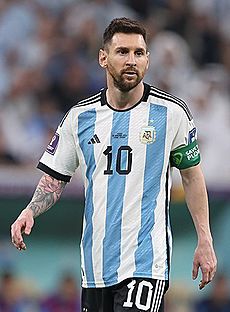
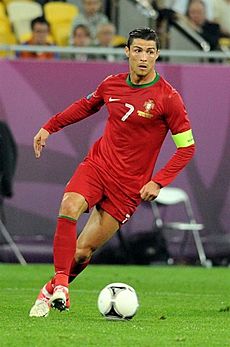
Six players share the record for playing in the most World Cups (five tournaments). These include Mexico's Antonio Carbajal, Rafael Márquez, and Andrés Guardado; Germany's Lothar Matthäus; Argentina's Lionel Messi; and Portugal's Cristiano Ronaldo. Ronaldo is also the first and only player to score in five different tournaments. Messi has played the most World Cup matches overall, with 26 appearances.
Miroslav Klose of Germany is the all-time top scorer in the World Cup with 16 goals. He broke Ronaldo of Brazil's record in 2014. France's Just Fontaine holds the record for most goals in a single World Cup, scoring 13 goals in 1958.
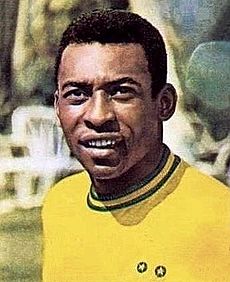
Brazil's Pelé is the only player to have won three World Cup winners' medals (1958, 1962, and 1970). Twenty other players have won two medals. Seven players have won all three types of World Cup medals (gold, silver, and bronze).
Brazil's Mário Zagallo, West Germany's Franz Beckenbauer, and France's Didier Deschamps are the only people to win the World Cup as both a player and a head coach. Italy's Vittorio Pozzo is the only head coach to win two World Cups (1934 and 1938). All World Cup-winning head coaches have been from the country they coached to victory.
Brazil has played the most World Cup matches (114), has the most wins (76), and has scored the most goals (237). Germany has appeared in the most finals (8) and semi-finals (13).
Top Goalscorers
- Individual
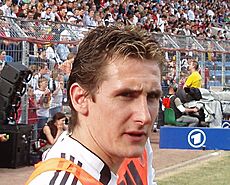
| Rank | Player | Goals | Matches | Goals per game |
|---|---|---|---|---|
| 1 | 16 | 24 | 0.67 | |
| 2 | 15 | 19 | 0.84 | |
| 3 | 14 | 13 | 1.08 | |
| 4 | 13 | 6 | 2.17 | |
| 13 | 26 | 0.50 | ||
| 6 | 12 | 14 | 0.86 | |
| 12 | 14 | 0.86 | ||
| 8 | 11 | 5 | 2.20 | |
| 11 | 17 | 0.65 | ||
| 10 | 10 | 10 | 1.00 | |
| 10 | 12 | 0.83 | ||
| 10 | 12 | 0.83 | ||
| 10 | 13 | 0.77 | ||
| 10 | 19 | 0.53 | ||
| 10 | 20 | 0.50 |
- Country
| Rank | National team | Goals scored |
|---|---|---|
| 1 | 237 | |
| 2 | 232 | |
| 3 | 152 | |
| 4 | 136 | |
| 5 | 128 | |
| 6 | 108 | |
| 7 | 104 | |
| 8 | 96 | |
| 9 | 89 | |
| 10 | 87 |
Awards
At the end of each World Cup, special awards are given to players and teams.
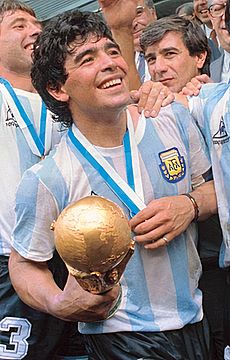
- The Golden Ball is for the best player in the tournament. It started in 1982.
- The Golden Boot is for the top goalscorer. It also started in 1982.
- The Golden Glove is for the best goalkeeper. This award began in 1994.
- The FIFA Young Player Award is for the best player under 21 years old. It was first given in 2006.
- The FIFA Fair Play Trophy is for the team that shows the best sportsmanship. It started in 1970.
Fans also vote for some awards:
- The Player of the Match is for the best player in each game. This started in 2002.
- The Goal of the Tournament is for the best goal scored in the World Cup, chosen by fans. It began in 2006.
- The Most Entertaining Team is chosen by the public.
See also
 In Spanish: Copa Mundial de Fútbol para niños
In Spanish: Copa Mundial de Fútbol para niños
- List of FIFA World Cup finals
- FIFA World Cup records and statistics
- FIFA World Cup awards
- FIFA U-20 World Cup
- FIFA U-17 World Cup
- FIFA Club World Cup
- FIFA Beach Soccer World Cup
- FIFA Futsal World Cup
- FIFA Confederations Cup
- List of association football competitions


